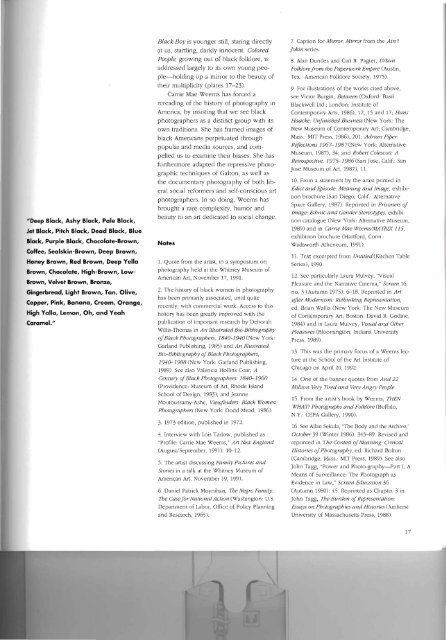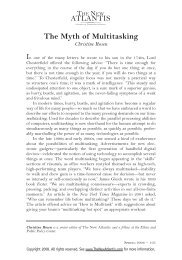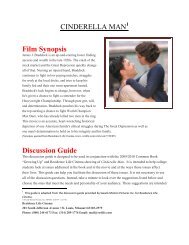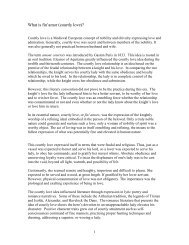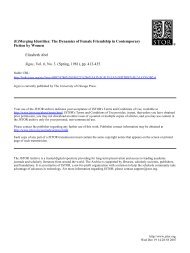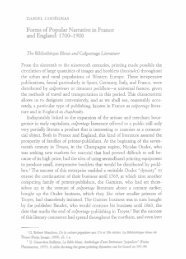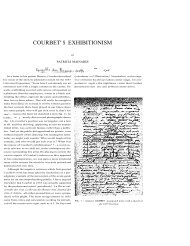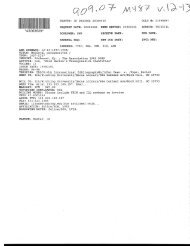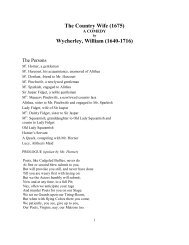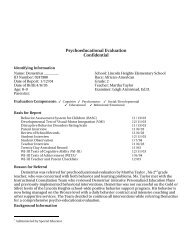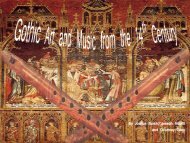CARRIE MAE WEEMS - People Search Directory
CARRIE MAE WEEMS - People Search Directory
CARRIE MAE WEEMS - People Search Directory
You also want an ePaper? Increase the reach of your titles
YUMPU automatically turns print PDFs into web optimized ePapers that Google loves.
"Deep Black, Ashy Black, Pale Black,<br />
Jet Black, Pikh Black, Dead Black, Blue<br />
Black, Purple Black, Chocolate-Brown,<br />
Coffee, Sealskin-Brown, Deep Brown,<br />
Honey Brown, Red Brown, Deep Yella<br />
Brown, Chocolate, High-Brown, Low<br />
Brown, Velvet Brown, Bronze,<br />
Gingerbread, Light Brown, Tan, Olive,<br />
Copper, Pink, Banana, Cream, Orange,<br />
High Yalla, Lemon, Oh, and Yeah<br />
Caramel."<br />
Black Boy is younger still, staring directly<br />
at us, startling, darkly innocent. Colored<br />
<strong>People</strong>, growing out of black folklore, is<br />
addressed largely to its own young people-holding<br />
up a mirror to the beauty of<br />
their multiplicity (plates 17-23)<br />
Carrie Mae Weems has forced a<br />
rereading of the history of photography in<br />
America, by insisting that we see black<br />
photographers as a distinct group with its<br />
own traditions. She has framed images of<br />
black Americans perpetuated through<br />
popular and media sources, and compelled<br />
us to examine their biases. She has<br />
furthermore adapted the repressive photographic<br />
techniques of Galton, as well as<br />
the documentary photography of both liberal<br />
social reformers and self-conscious art<br />
photographers. In so doing, Weems has<br />
brought a rare complexity, humor and<br />
beauty to an art dedicated to social change.<br />
Notes<br />
1. Quote from the artist, in a symposium on<br />
photography held at the Whitney Museum of<br />
American An, November 17, 1991.<br />
2. The history of black women in photography<br />
has been primarily aSSOCiated, until quite<br />
recently, with commercial work. Access to this<br />
history has been greatly improved with the<br />
publication of important research by Deborah<br />
Willis-Thomas in An !IIustrated Bio-Bibliograpby<br />
o/Black Pbotographers, 1840-1940 (New York:<br />
Garland Publishing, 1985) and An Illustrated<br />
Bio-Bibliography o/Black Photograpbers,<br />
1940-1988 (New York: Garland Publishing,<br />
1989} See also ValenCia Hollins Coal', A<br />
Century o/Black Photographers. 1840-1960<br />
(Providence: Museum of Art, Rhode Island<br />
School of Design, 1983); and Jeanne<br />
Moutoussamy-Ashe, ViewJinders: Black Women<br />
Photographers (New York: Dodd Mead, 1986).<br />
3. 1973 edition, published in 1972<br />
4. Interview with Lois Tarlow, published as<br />
"Profile: Carrie Mae Weems," Art New England<br />
(August/September, 1991): 10-12.<br />
5. The artist discussing Family Pictu.res and<br />
Stories in a talk at the Whitney Museum of<br />
American An, November 19, 1991.<br />
6. Daniel Patrick Moynihan, The Negro Family:<br />
The Case/or National Action (Washington: U.S.<br />
Department of La bor, Office of Policy Planning<br />
and Research, 1965).<br />
7. Caption for Mirror, Mirror from the Ain't<br />
Jokin series.<br />
8. Alan Dundes and Carl R. Pagter, Urban<br />
Folklorefrom the Paperwork Empire (Austin,<br />
Tex: American Folklore Society, 1975}<br />
9 For illustrations of the works cited above,<br />
see Vietor Burgin, Between (Oxford: Basil<br />
Blackwell Ltd.; London: Institute of<br />
Contemporary Arts, 1986), 12, 15 and 17; Hans<br />
Haacke. UnJinished Business (New York: The<br />
New Museum of Contemporary Art; Cambridge,<br />
Mass.: MIT Press, 1986), 201; Adnan Piper·<br />
Reflections 1967-1987(New York: Alternative<br />
Museum, 1987), 34; and Robert Colescott A<br />
Retrospective, 197~1986(San Jose, Calif.: San<br />
Jose Museum of AJ1, 1987), 11.<br />
10. From a statement by the anist printed in<br />
Edict and Episode: Meaning and Image, exhibition<br />
brochure (San Diego, Calif: Alternative<br />
Space Gallery, 1987). Reprinted in Prisoners 0/<br />
Image: Ethnic and Gender Stereotypes, exhibition<br />
catalogue (New York: Alternative Museum,<br />
1989) and in Carrie Mae WeemsiMATRJX 115,<br />
exhibition brochure (Hartford, Conn.:<br />
Wadsworth Atheneum, 1991).<br />
11. Text excerpted from Untitled (Kitchen Table<br />
Series), 1990.<br />
12. See particularly Laura Mulvey, "Visual<br />
Pleasure and the Narrative Cinema," Screen 16,<br />
no. 3 (Autumn 1975): 6-18. Reprinted in Art<br />
after Modernism' Rethinking Representation,<br />
ed. Brian Wallis (New York: The New Museum<br />
of Contemporary Art; Boston: David R. Godine,<br />
1984) and in Laura Mulvey, Visual and Other<br />
Pleasures (Bloomington: Indiana University<br />
Press, 1989}<br />
13. This was the primary focus of a Weems lecture<br />
at the School of the Art Institute of<br />
Chicago on April 20, 1992.<br />
14. One of the banner quotes from And 22<br />
Million Very Tired and Very Angry <strong>People</strong><br />
15. From the artist's book by Weems, mEN<br />
\.\7HA'J? Photographs and Folklore (Buffalo,<br />
N.Y.: CEPA GalJery, 1990).<br />
16 See Allan Sekula, "TI1e Body and the Archive,"<br />
October 39 (Winter 1986): 343-89. Revised and<br />
reprinted in Tbe Contest 0/Meaning: Critical<br />
Histones o/Photograpby, ed. Richard Bolton<br />
(Cambridge, Mass.: MIT Press, 1989). See also<br />
John Tagg, "Power and Photo-graphy-Part I, A<br />
Means of SUlveillance: The Photograph as<br />
Evidence in Law," Screen Education 36<br />
(Autumn 1980): 45. Reprinted as Chapter 3 in<br />
John Tagg, The Burden o/Representation.<br />
Essays on. Pbotograpbies and Histories (Amherst:<br />
University of Massachusetts Press, 1988)<br />
17


